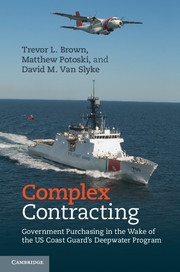Book contents
- Frontmatter
- Contents
- List of figure and tables
- Foreword
- 1 Introduction: the promise and perils of government contracting
- 2 Managing complex contracting in theory and practice
- 3 The Coast Guard’s Deepwater program
- 4 Rules in complex contracts
- 5 Performance incentives in complex contracts
- 6 Complex contracting’s promise and pitfalls: win-win and lose-lose
- 7 Management strategies for complex contracts
- References
- Index
5 - Performance incentives in complex contracts
Published online by Cambridge University Press: 05 August 2013
- Frontmatter
- Contents
- List of figure and tables
- Foreword
- 1 Introduction: the promise and perils of government contracting
- 2 Managing complex contracting in theory and practice
- 3 The Coast Guard’s Deepwater program
- 4 Rules in complex contracts
- 5 Performance incentives in complex contracts
- 6 Complex contracting’s promise and pitfalls: win-win and lose-lose
- 7 Management strategies for complex contracts
- References
- Index
Summary
THE $4 MILLION PERFORMANCE BONUS
Therefore, upon the basis of the above findings, and with the recommendation of the Performance Evaluation Board, I concur with their adjectival rating of “Very Good” in that ICGS has demonstrated very effective performance during the course of the one year period of performance for CLIN 0001. However, based upon the above findings, I do not concur with the recommended numerical score and hereby determine the Award Fee numerical score is 87%. I also determine, for the reasons stated in paragraph 10 above including the complexity of this acquisition and the learning curve during the first-year, to reallocate 100% of the excess Award Fee into CLIN 0002 Award Fee pool (50% into the first six month period and 50% into the second six month period). The Contracting Officer will convert the percentage score to a dollar value and provide a copy of this Determination to ICGS (Stillman, 2004).
And with that assessment on September 3, 2003, the Coast Guard gave ICGS a performance bonus (called an “Award Fee”) of just over $4 million out of a potential $4.6 million for its work during the first year of the Deepwater contract (USCG, 2003b). The Coast Guard moved the remaining $600,000 to the contract’s second year performance fee pool, giving ICGS another shot at the money. After a year of NSC production problems (i.e. structural deficiencies in the hull, stern ramp doors failing to work properly, and problems with the onboard helicopter hangar technology) and the problems with the P-123 patrol boats (i.e. hull buckling, security breaches in the C4ISR), the evaluation seemed to suggest the Coast Guard was giving ICGS a pat on the back, saying “very good” job.
- Type
- Chapter
- Information
- Complex ContractingGovernment Purchasing in the Wake of the US Coast Guard's Deepwater Program, pp. 138 - 172Publisher: Cambridge University PressPrint publication year: 2013

